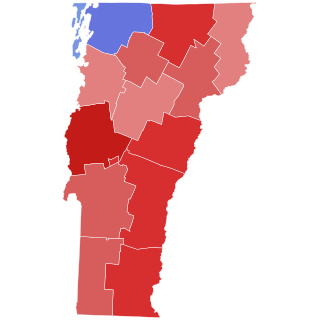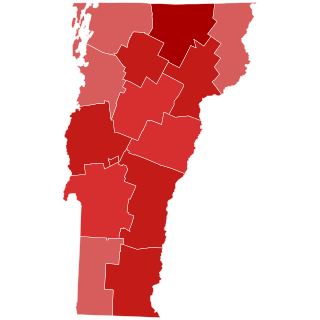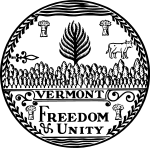
The 1926 Vermont gubernatorial election took place on November 2, 1926. Incumbent Republican Franklin S. Billings, per the "Mountain Rule", did not run for re-election to a second term as Governor of Vermont. Republican candidate John E. Weeks defeated Democratic candidate Herbert C. Comings to succeed him.

The 1924 Vermont gubernatorial election took place on November 4, 1924. Per the "Mountain Rule", incumbent Republican Redfield Proctor Jr. did not run for re-election to a second term as Governor of Vermont. Republicans nominated Franklin S. Billings. The Democratic nomination was won by Howard E. Shaw. Shaw died before the general election, and the Vermont Democratic Party selected Fred C. Martin as his replacement. Billings defeated Martin in the general election and succeeded Proctor.

The 1922 Vermont gubernatorial election took place on November 7, 1922. Incumbent Republican James Hartness, per the "Mountain Rule", did not run for re-election to a second term as Governor of Vermont. Republican candidate Redfield Proctor Jr. defeated Democratic candidate John Holmes Jackson to succeed him.

The 1920 Vermont gubernatorial election took place on November 2, 1920. Incumbent Republican Percival W. Clement, per the "Mountain Rule", did not run for re-election to a second term as Governor of Vermont. Republican candidate James Hartness defeated Democratic candidate Fred C. Martin to succeed him.

The 1918 Vermont gubernatorial election took place on November 5, 1918. Incumbent Republican Horace F. Graham, per the "Mountain Rule", did not run for re-election to a second term as Governor of Vermont. Republican candidate Percival W. Clement defeated Democratic candidate William B. Mayo to succeed him.

The 1916 Vermont gubernatorial election took place on November 7, 1916. Incumbent Republican Charles W. Gates, per the "Mountain Rule", did not run for re-election to a second term as Governor of Vermont. Republican candidate Horace F. Graham defeated Democratic candidate William B. Mayo to succeed him.

The 1914 Vermont gubernatorial election took place on November 3, 1914. Incumbent Republican Allen M. Fletcher, per the "Mountain Rule", did not run for re-election to a second term as Governor of Vermont. Republican candidate Charles W. Gates defeated Democratic candidate Harland B. Howe and Progressive candidate Walter J. Aldrich to succeed him.

The 1912 Vermont gubernatorial election took place on September 3, 1912. Incumbent Republican John A. Mead, per the "Mountain Rule", did not run for re-election to a second term as Governor of Vermont. Republican candidate Allen M. Fletcher defeated Democratic candidate Harland B. Howe and Progressive candidate Fraser Metzger to succeed him. Since no candidate won a majority of the popular vote, the election was decided by the Vermont General Assembly in accordance with the state constitution, where Fletcher was elected with 163 votes to 76 for Howe and 32 for Metzger.

The 1910 Vermont gubernatorial election took place on September 6, 1910. Incumbent Republican George H. Prouty, per the "Mountain Rule", did not run for re-election to a second term as Governor of Vermont. Republican candidate John A. Mead defeated Democratic candidate Charles D. Watson to succeed him.

The 1908 Vermont gubernatorial election took place on September 1, 1908. Incumbent Republican Fletcher D. Proctor, per the "Mountain Rule", did not run for re-election to a second term as Governor of Vermont. Republican candidate George H. Prouty defeated Democratic candidate, Burlington mayor James Edmund Burke to succeed him.

The 1904 Vermont gubernatorial election took place on September 6, 1904. Incumbent Republican John G. McCullough, per the "Mountain Rule", did not run for re-election to a second term as Governor of Vermont. Republican candidate Charles J. Bell defeated Democratic candidate Eli H. Porter to succeed him.

The 1902 Vermont gubernatorial election took place on September 2, 1902. Incumbent Republican William W. Stickney, per the "Mountain Rule", did not run for re-election to a second term as Governor of Vermont. Republican candidate John G. McCullough defeated Local Option candidate Percival W. Clement and Democratic candidate Felix W. McGettrick to succeed him. Since no candidate won a majority of the popular vote, the election was decided by the Vermont General Assembly in accordance with the state constitution, where McCullough was elected with 164 votes to 59 for Clement and 45 for McGettrick.

The 1900 Vermont gubernatorial election took place on September 4, 1900. Incumbent Republican Edward C. Smith, per the "Mountain Rule", did not run for re-election to a second term as Governor of Vermont. Republican candidate William W. Stickney defeated Democratic candidate John H. Senter to succeed him.

The 1898 Vermont gubernatorial election took place on September 6, 1898. Incumbent Republican Josiah Grout, per the "Mountain Rule", did not run for re-election to a second term as Governor of Vermont. Republican candidate Edward C. Smith defeated Democratic candidate Thomas W. Moloney to succeed him.

The 1896 Vermont gubernatorial election took place on September 1, 1896. Incumbent Republican Urban A. Woodbury, per the "Mountain Rule", did not run for re-election to a second term as Governor of Vermont. Republican candidate Josiah Grout defeated Democratic candidate J. Henry Jackson to succeed him.

The 1894 Vermont gubernatorial election took place on September 4, 1894. Incumbent Republican Levi K. Fuller, per the "Mountain Rule", did not run for re-election to a second term as Governor of Vermont. Republican candidate Urban A. Woodbury defeated Democratic candidate George W. Smith to succeed him.

The 1892 Vermont gubernatorial election took place on September 6, 1892. Incumbent Republican Carroll S. Page, per the "Mountain Rule", did not run for re-election to a second term as Governor of Vermont. Republican candidate Levi K. Fuller defeated Democratic candidate B. B. Smalley to succeed him.

The 1890 Vermont gubernatorial election took place on September 2, 1890. Incumbent Republican William P. Dillingham, per the "Mountain Rule", did not run for re-election to a second term as Governor of Vermont. Republican candidate Carroll S. Page defeated Democratic candidate Herbert F. Brigham to succeed him.

The 1878 Vermont gubernatorial election took place on September 3, 1878. Incumbent Republican Horace Fairbanks, per the "Mountain Rule", did not run for re-election to a second term as Governor of Vermont. Republican candidate Redfield Proctor defeated Democratic candidate W. H. H. Bingham to succeed him.

The 1872 Vermont gubernatorial election took place on September 3, 1872. Incumbent Republican John W. Stewart, per the "Mountain Rule", did not run for re-election to a second term as Governor of Vermont. Republican candidate Julius Converse defeated Liberal Republican and Democratic nominee Abraham B. Gardner to succeed him.























